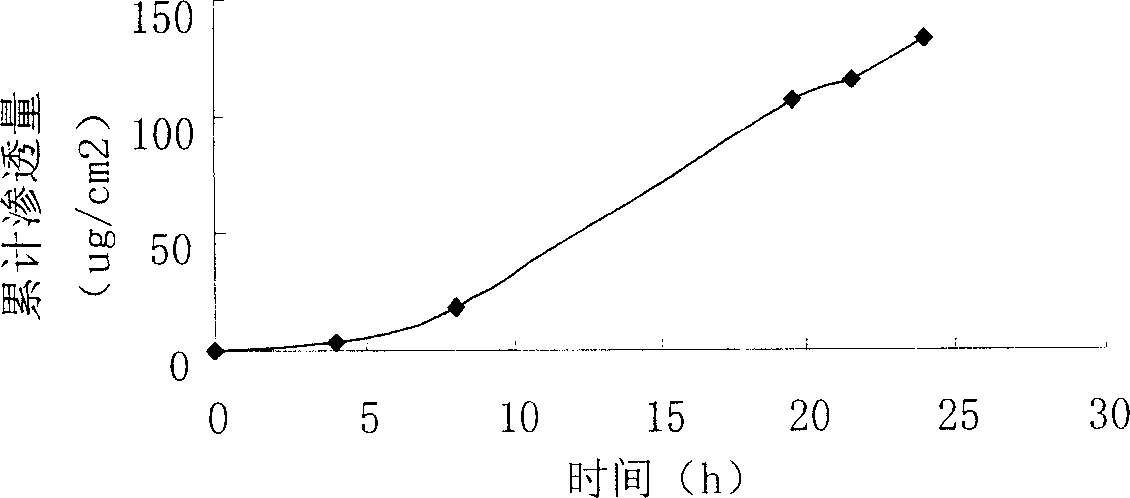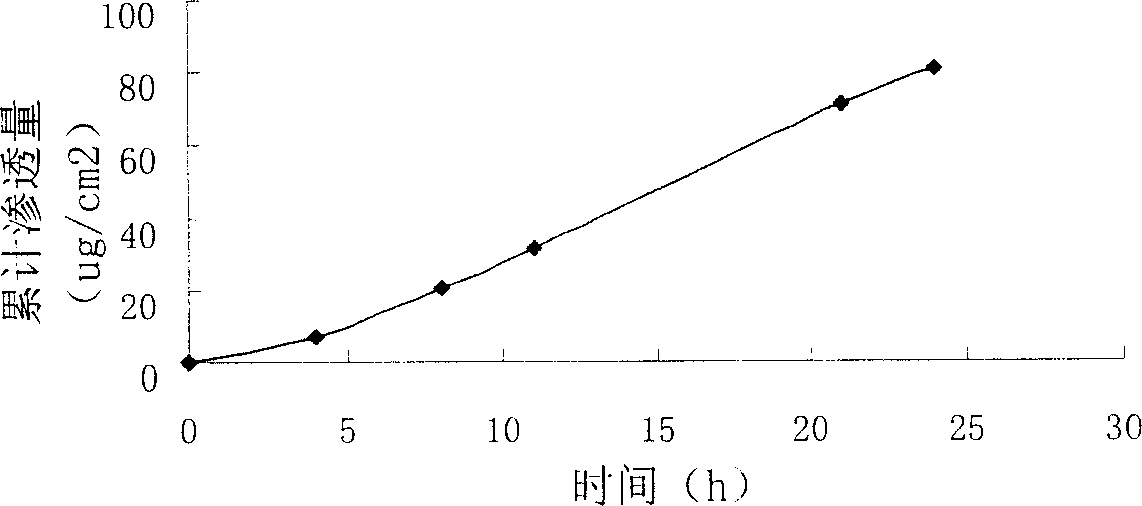Ethinyl estradiol gas permeable absorbing gel
A technology of ethinyl estradiol and gel, applied in the field of pharmacy, can solve the problems such as the amount of penetration through the skin, the penetration rate cannot meet the treatment requirements, etc., and achieve the effects of increasing the penetration rate and being convenient to use.
- Summary
- Abstract
- Description
- Claims
- Application Information
AI Technical Summary
Problems solved by technology
Method used
Image
Examples
Embodiment 1
[0019] Weigh 200mg of Carbomer 934, add 3-4ml of water, and swell for about 1 hour. Separately weigh 20 mg of ethinyl estradiol and 2 mg of methylparaben, add 3 g of ethanol and 1.5 g of propylene glycol to dissolve them, and mix them evenly with carbomer, drop triethanolamine to cross-link until neutral, and keep stirring to make the mixture Uniform transparent gel, add water to 10g. Stir well, and use the improved Franze diffusion cell device to measure its permeability to human skin in vitro, and the receiving solution is 20% polyethylene glycol 400 (PEG400) physiological saline solution. Use HPLC to measure ethinyl estradiol, the wavelength is 281nm, the mobile phase is 70% methanol, 30% water, the flow rate is 1ml / min, for ethinyl estradiol, the retention time is about 5.5min, and the permeation rate is 6.78μg / cm 2 h, figure 1 It is the drug cumulative penetration-time curve of this embodiment.
Embodiment 2
[0021] Weigh 200mg of Carbomer 934, add 3-4ml of water, and swell for about 1 hour. In addition, weigh 20 mg of ethinyl estradiol and 2 mg of methylparaben, add 4 g of ethanol and 1.5 g of propylene glycol to dissolve them, and mix them evenly with carbomer, drop triethanolamine to cross-link until neutral, and keep stirring to make the mixture Uniform transparent gel, add water to 10g. A modified Franze diffusion cell device was used to measure its permeability to human skin in vitro, and the receiving solution was 20% polyethylene glycol 400 (PEG400) physiological saline aqueous solution. Use HPLC to measure ethinyl estradiol, the wavelength is 281nm, the mobile phase is 70% methanol, 30% water, the flow rate is 1ml / min, for ethinyl estradiol, the retention time is about 5.5min, and the permeation rate is 6.117μg / cm 2 h, figure 2 It is the drug cumulative penetration-time curve of this embodiment.
Embodiment 3
[0023] Weigh 200mg of Carbomer 934, add 3-4ml of water, and swell for about 1 hour. Separately weigh 20 mg of ethinyl estradiol and 2 mg of methylparaben, add 2 g of ethanol and 1.5 g of propylene glycol to dissolve them, and mix them evenly with carbomer, drop triethanolamine to cross-link until neutral, and keep stirring to make the mixture Uniform transparent gel, add water to 10g. A modified Franze diffusion cell device was used to measure its permeability to human skin in vitro, and the receiving solution was 20% polyethylene glycol 400 (PEG400) physiological saline aqueous solution. Use HPLC to measure ethinyl estradiol, the wavelength is 281nm, the mobile phase is 70% methanol, 30% water, the flow rate is 1ml / min, for ethinyl estradiol, the retention time is about 5.5min, and the permeation rate is 3.79μg / cm 2 h. image 3 It is the drug cumulative penetration-time curve of this embodiment.
PUM
 Login to View More
Login to View More Abstract
Description
Claims
Application Information
 Login to View More
Login to View More - R&D Engineer
- R&D Manager
- IP Professional
- Industry Leading Data Capabilities
- Powerful AI technology
- Patent DNA Extraction
Browse by: Latest US Patents, China's latest patents, Technical Efficacy Thesaurus, Application Domain, Technology Topic, Popular Technical Reports.
© 2024 PatSnap. All rights reserved.Legal|Privacy policy|Modern Slavery Act Transparency Statement|Sitemap|About US| Contact US: help@patsnap.com










